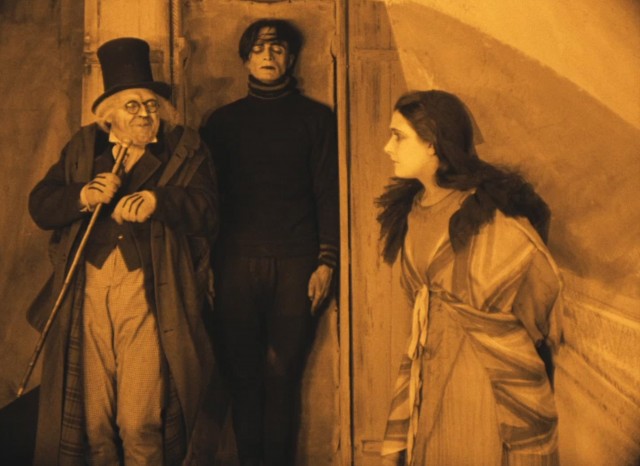THE CABINET OF DR. CALIGARI (DAS CABINET DES DR. CALIGARI) (Robert Wiene, 1920)
Film Forum
209 West Houston St.
October 31 – November 6
212-727-8110
www.filmforum.org
www.kinolorber.com
 Back in high school, we saw The Cabinet of Dr. Caligari for the first time in the somewhat dubious “Christian Values in Film” class. The verdict: The Cabinet of Dr. Caligari has no Christian values. But the Caligari we saw back then is rather different from the one we saw earlier this week, a 4K digital restoration from the original camera negative by the Friedrich Murnau Foundation and with a fresh new score by John Zorn. This sparkling Caligari is now the only way to see this truly frightening work, one of the most influential horror films of all time. You can find elements of Paul Wegener’s The Golem, James Whale’s Frankenstein and The Bride of Frankenstein, and Todd Browning’s Dracula — all three of which followed this truly seminal film — in this twisted, unsettling psychological thriller of murder and mayhem involving the mysterious Dr. Caligari (Werner Krauss) and the creepy somnambulist he controls, Cesare (Casablanca’s Conrad Veidt), who predicts the future and eerily walks in his sleep. The tale is told in a frame story by Francis (Friedrich Fehér), who, like his best friend, Alan (Hans Heinrich von Twardowski), is in love with Jane (Lil Dagover). The only problem is that Cesare might have a thing for her as well.
Back in high school, we saw The Cabinet of Dr. Caligari for the first time in the somewhat dubious “Christian Values in Film” class. The verdict: The Cabinet of Dr. Caligari has no Christian values. But the Caligari we saw back then is rather different from the one we saw earlier this week, a 4K digital restoration from the original camera negative by the Friedrich Murnau Foundation and with a fresh new score by John Zorn. This sparkling Caligari is now the only way to see this truly frightening work, one of the most influential horror films of all time. You can find elements of Paul Wegener’s The Golem, James Whale’s Frankenstein and The Bride of Frankenstein, and Todd Browning’s Dracula — all three of which followed this truly seminal film — in this twisted, unsettling psychological thriller of murder and mayhem involving the mysterious Dr. Caligari (Werner Krauss) and the creepy somnambulist he controls, Cesare (Casablanca’s Conrad Veidt), who predicts the future and eerily walks in his sleep. The tale is told in a frame story by Francis (Friedrich Fehér), who, like his best friend, Alan (Hans Heinrich von Twardowski), is in love with Jane (Lil Dagover). The only problem is that Cesare might have a thing for her as well.
A masterpiece that set high the bar for German Expressionism, The Cabinet of Dr. Caligari might have been shocking when it debuted in 1920, but it’s still shocking today, like nothing you’ve ever seen, with one of the most memorable, enigmatic villains ever put on celluloid. It’s not a traditional silent black-and-white film, instead tinted in blue and gold, with intertitles exploding in a wild green font. The sets, by Hermann Warm, Walter Reimann, and Walter Röhrig, are sharply slanted, with crazy angles and perspectives and backdrops that include unmoving shadows painted right on them; they’re obviously fake and very fragile, adding yet more levels of weirdness. Written by Hans Janowitz and Carl Mayer, photographed by Willy Hameister (irising in and out, occasionally at the same time), and directed by Robert Wiene (Raskolnikov, Der Rosenkavalier), The Cabinet of Dr. Caligari is thick with an ominous, sinister atmosphere that is sheer pleasure; you’ll find yourself smiling at the beauty of it all even as you tense up at the hair-raising proceedings. It is that rare film that works as historical document as well as pure entertainment, a treat for cinema enthusiasts and horror fans alike, especially when the twist ending turns everything inside out and upside down. The Cabinet of Dr. Caligari will be scaring audiences for a week at Film Forum beginning on Halloween, Christian values or not.
